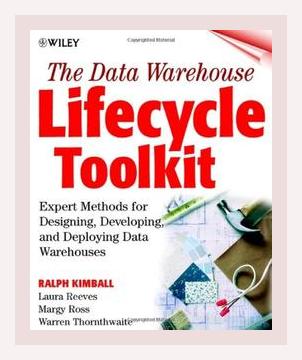Technology and Digital TransformationData Analytics
The Data Warehouse Lifecycle Toolkit (1998) – Summary
Authors: Ralph Kimball, Laura Reeves, Margy Ross, Warren Thornthwaite
Categories: Data Analytics
Introduction
“The Data Warehouse Lifecycle Toolkit” by Ralph Kimball and his co-authors offers a detailed, practical guide for building and maintaining data warehouses. The book is constructed around the lifecycle of a data warehouse project, emphasizing a structured approach from initial planning to deployment and ongoing maintenance. It integrates both technical considerations and project management methodologies, suitable for data analysts, IT professionals, and business stakeholders.
1. Project Planning and Management
Major Points:
- Scope Definition: Establishing clear boundaries and objectives for the data warehouse to ensure alignment with business goals.
- Stakeholder Engagement: Actively involving business users and sponsors to garner support and provide essential insights.
- Resource Allocation: Securing adequate budget, technology, and human resources to ensure project feasibility and success.
Action:
- Prepare a comprehensive project charter detailing the goals, stakeholders, scope, and resources needed. For example, clearly outline that your data warehouse aims to enhance sales reporting efficiency across different regions.
2. Business Requirements Definition
Major Points:
- Requirement Gathering: Conducting interviews and workshops with business users to understand their data needs and analytical objectives.
- Prioritization: Classifying requirements based on their impact and feasibility to streamline development efforts.
- Documentation: Creating detailed documentation to capture the business requirements clearly and concisely.
Action:
- Organize a series of workshops with departmental heads to discuss and prioritize their analytics requirements. Document these interactions in a requirements traceability matrix to keep track.
3. Dimensional Modeling
Major Points:
- Star Schema Design: Organizing data into fact and dimension tables to support efficient querying and reporting.
- Grain Definition: Determining the granularity of the fact tables to ensure proper balance between detail and performance.
- Conformed Dimensions: Designing dimensions that are reusable across various parts of the data warehouse to maintain data consistency.
Action:
- Create a star schema to model sales transactions with fact tables for sales amounts and dimensions for time, geography, and product. For example, ensure that the “Time” dimension is consistent and reusable across all business models.
4. Physical Design
Major Points:
- Indexing: Implementing appropriate indexing strategies to optimize query performance.
- Partitioning: Employing partitioning to manage large tables and improve performance.
- Storage Optimization: Choosing suitable storage options to facilitate quick data retrieval and cost efficiency.
Action:
- Partition fact tables by date to speed up queries that filter by time period. Create indexes on frequently used columns like customer ID to reduce query runtimes.
5. ETL (Extract, Transform, Load) Process
Major Points:
- Data Extraction: Retrieving data from multiple heterogeneous sources while ensuring accuracy and completeness.
- Data Transformation: Cleaning, integrating, and transforming data to conform to the warehouse schema.
- Data Loading: Loading transformed data into the data warehouse effectively, maintaining data integrity.
Action:
- Design ETL processes to extract data from your CRM and ERP systems. Use data mapping to transform this data into a normalized format before loading it into your sales fact tables.
6. Data Quality Assurance
Major Points:
- Quality Checks: Implementing checks to identify and address data quality issues such as duplicates, missing values, and inaccuracies.
- Metadata Management: Curating comprehensive metadata to support data quality initiatives and user guidance.
- Data Governance: Establishing policies and procedures to manage data quality consistently over time.
Action:
- Define and implement quality metrics like data accuracy and completeness. Regularly audit the data quality and establish governance frameworks to ensure data integrity.
7. Data Warehouse Deployment
Major Points:
- Incremental Rollouts: Deploying the warehouse in stages to allow for user feedback and iterative improvements.
- User Training: Providing comprehensive training sessions for end-users to ensure effective usage of the data warehouse.
- Performance Monitoring: Continuously monitoring system performance and making necessary adjustments.
Action:
- Roll out the data warehouse to a pilot group of users, solicit feedback and resolve issues before wider deployment. Conduct user training sessions focusing on key functionalities of the data warehouse tools.
8. Maintenance and Growth
Major Points:
- Regular Updates: Continuously updating the data warehouse to accommodate changing business requirements and new data sources.
- Scalability Planning: Building a scalable architecture that can grow with the increasing data volumes and user base.
- Performance Tuning: Continuously tuning performance to ensure optimal system operation and user experience.
Action:
- Schedule regular updates to your ETL processes to incorporate new data sources and enhance data models. Regularly review system performance and adjust infrastructure resources as needed.
Concluding Insights
Major Points:
- User Engagement: Encouraging a culture of continuous improvement and user involvement to maximize the benefits of the data warehouse.
- Agility: Maintaining flexibility to adapt to new technologies and methods as the data landscape evolves.
- Collaboration: Fostering collaboration between IT and business users to ensure the data warehouse meets real, actionable business needs.
Action:
- Set up a data governance committee involving both technical and business stakeholders to guide ongoing improvements and adjustments to the data warehouse.
Summary
“The Data Warehouse Lifecycle Toolkit” by Ralph Kimball and his co-authors is more than just a technical manual; it’s a comprehensive guide to building and maintaining an effective data warehouse through a structured, yet flexible, project lifecycle. By following the key steps outlined in the book—from planning, gathering business requirements, and modeling data, to physical design, ETL processes, quality assurance, deployment, and ongoing maintenance—organizations can create data warehouses that align closely with their business objectives, deliver high data quality, and support strategic decision-making.
Concrete examples like creating star schemas, partitioning tables, and implementing data governance underscore the practical application of the book’s principles. Actionable steps such as organizing user workshops, establishing metadata management practices, and rolling out the warehouse incrementally help translate theory into practice, ensuring that readers can effectively manage their data warehouse projects and achieve sustainable success.
